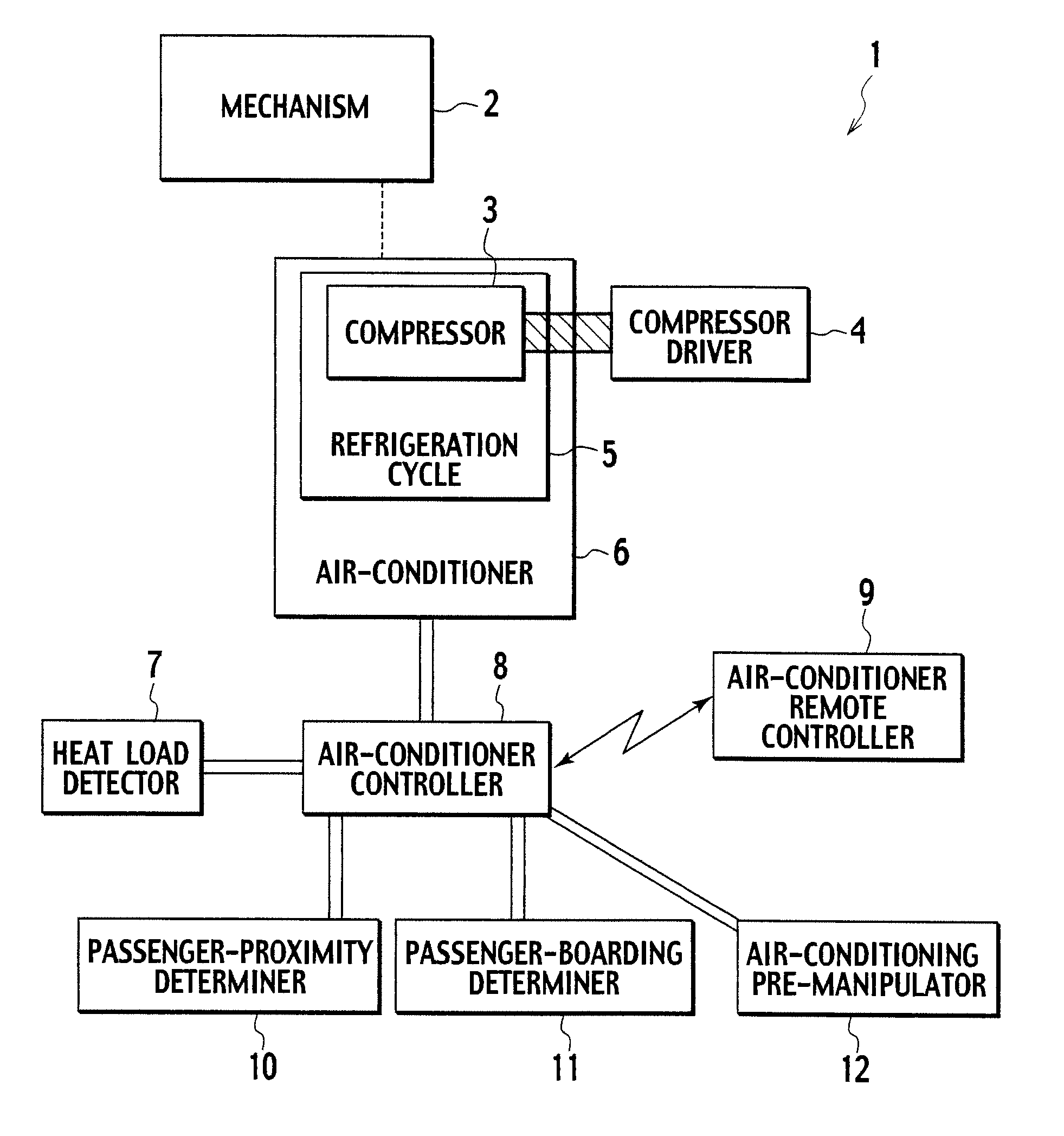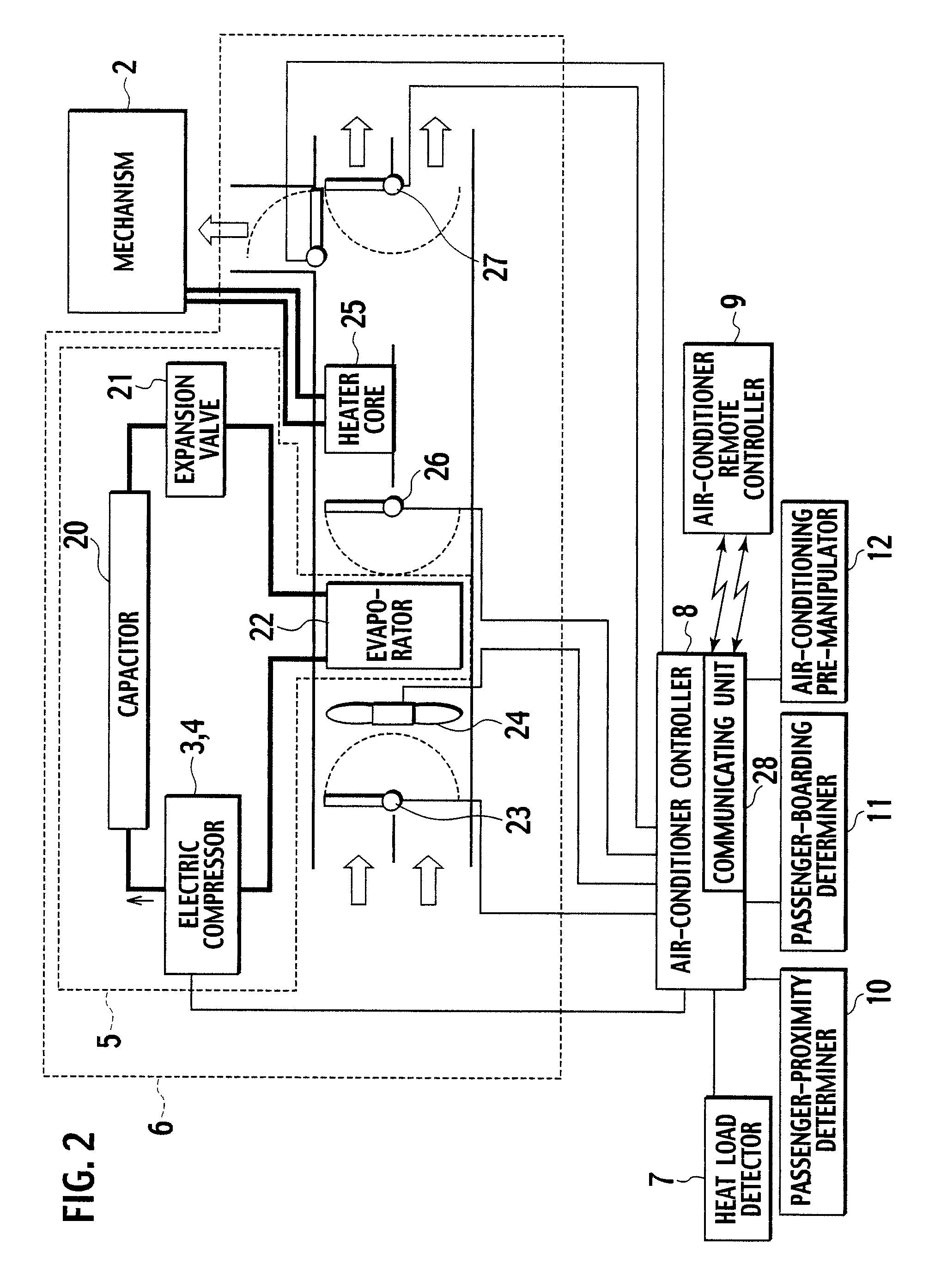Vehicle air-conditioner control system
a control system and air conditioner technology, applied in the direction of process control, lighting and heating apparatus, instruments, etc., can solve the problems of insufficient air conditioning, many air in the air-conditioned compartment may disadvantageously flow to the outside of the compartment, and none of the conventional air-conditioners described above have given due consideration to air-conditioning comfort, etc., to achieve sufficient air-conditioning and reduce the disagreeableness of air-conditioning wind and compressor nois
- Summary
- Abstract
- Description
- Claims
- Application Information
AI Technical Summary
Benefits of technology
Problems solved by technology
Method used
Image
Examples
first embodiment
[0031]FIG. 1 is a block diagram showing a configuration of a vehicle air-conditioner control system according to a first embodiment.
[0032]As shown in FIG. 1, a vehicle air-conditioner control system 1 according to the present embodiment includes a mechanism 2 (hereinafter, “engine 2” where appropriate) such as a motor or an engine that generates a driving force of a vehicle 40, a compressor 3 that pressurizes and compresses a refrigerant of a refrigeration cycle, a compressor driver 4 driving the compressor 3, a refrigeration cycle 5 including the compressor 3, a refrigeration cycle unit, a heat exchanger, a piping and the like, an air conditioner (air-conditioning unit) 6 that includes the refrigeration cycle 5 and that supplies an air-conditioning wind into a vehicle compartment, a heat load detector (heat load detecting unit) 7 configured to detect heat load imposed on the compartment (e.g., solar radiation, outdoor air temperature, and compartment temperature), an air-conditione...
second embodiment
[0076]A second embodiment of the present invention will be explained with reference to the drawings. FIG. 11 is a block diagram showing a configuration of a vehicle in which a vehicle air-conditioner control system according to the present embodiment is mounted.
[0077]As shown in FIG. 11, the vehicle in which the vehicle air-conditioner control system according to the present embodiment is mounted uses a battery 90 as a power supply, and a battery storage-capacity monitor 91 monitors a storage capacity of the battery. A current from the battery 90 is supplied, via a power-supply switch (power-supply switching unit) 99, to a driving inverter 92 and a compressor inverter 93. The driving inverter 92 communicates with the battery storage-capacity monitor 91, controls current consumption according to the storage capacity of the battery 90 to regenerate vehicle driving energy, and adjusts the storage capacity of the battery 90.
[0078]The current supplied to the driving inverter 92 is suppli...
third embodiment
[0090]A third embodiment of the present invention will be explained with reference to the drawings. FIG. 13 is a block diagram showing a configuration of a vehicle in which a vehicle air-conditioner control system according to the present embodiment is mounted. As shown in FIG. 13, differently from the second embodiment, the vehicle mounting the vehicle air-conditioner control system according to the present embodiment includes a driving power-supply switch (driving power-supply switching unit) 103 that is provided between a battery 90 and a driving inverter 92, and a compressor power-supply switch (air-conditioner power-supply switching unit) 104 that is provided between the battery 90 and a compressor inverter 93. Since the other constituent elements of the vehicle in which the vehicle air-conditioner control system according to the present embodiment are identical with those according to the second embodiment, detailed explanations thereof will be omitted.
[0091]In the vehicle air...
PUM
 Login to View More
Login to View More Abstract
Description
Claims
Application Information
 Login to View More
Login to View More - R&D
- Intellectual Property
- Life Sciences
- Materials
- Tech Scout
- Unparalleled Data Quality
- Higher Quality Content
- 60% Fewer Hallucinations
Browse by: Latest US Patents, China's latest patents, Technical Efficacy Thesaurus, Application Domain, Technology Topic, Popular Technical Reports.
© 2025 PatSnap. All rights reserved.Legal|Privacy policy|Modern Slavery Act Transparency Statement|Sitemap|About US| Contact US: help@patsnap.com



